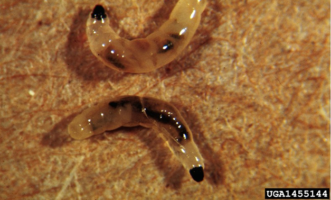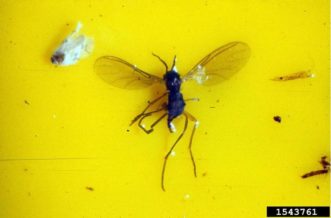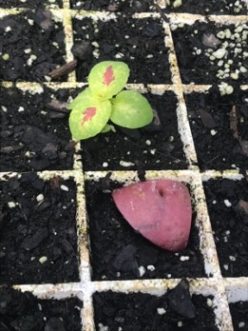Fungus gnats are major pests in ornamental plant propagation facilities; high organic matter content and moisture in the rooting media facilitate fungus gnat population growth and damage. Historically, propagation greenhouse managers rely on broad-spectrum insecticides, such as chlorpyrifos, to manage fungus gnats with varying degrees of success. Optimal management of fungus gnats must take an integrated approach due to the fungus gnats’ short life cycle, damage potential, and ability to take advantage of the humid condition in propagation greenhouses. An integrated pest management (IPM) program brings together multiple chemical and non-chemical control strategies to keep the fungus gnat population below damaging levels. The deployment of cultural and biological control tools also has the benefit of avoiding residual toxicity of some insecticides to biological control agents that growers may use during the finishing stage. The information in this publication will provide insight to growers and support the development of an integrated fungus gnat management program in propagation facilities.
Description and Life Cycle
Pestiferous fungus gnats in propagation greenhouses are typically the dark-winged fungus gnats in the genus Bradysia. Fungus gnat adults are small (1/8-inch-long), dark-bodied, mosquito-like flies, with a pair of wings, a pair of long antennae, and three pairs of long legs. They are weak flyers and are more frequently seen “dancing” on potting media surfaces and the rim of pots or trays rather than flying in the air or active in plant canopy. Although adult gnats are primarily nuisances to growers and consumers, they also play a role in disseminating plant pathogens to uninfected host plants.

Figure 1. Fungus gnat larvae. Image credit: Whitney Cranshaw, Colorado State University, Bugwood.org.
Fungus gnat larvae are transparent, black-headed, 1/4-inch-long maggots (figure 1) that are most active in the top two inches of media. The larvae feed primarily on fungi and other microorganisms in the media. They will also feed on and damage developing roots, causing poor rooting and wilting of cuttings and seedlings. Feeding damage to the roots can also inhibit root growth as well as water and nutrient uptake. When a population is large or when the plants are severely damaged, the larvae can be found feeding in stems and crowns and on leaves that touch the media. Wounds on the roots and stems allow invasion by various root, stem, and crown rot pathogens. Adults and larvae are known to carry spores of Thielaviopsis, Fusarium, and other pathogen species1, but their ability to increase disease incidence and severity is questionable.2 Fungus gnats are also attracted to Pythium-infected plants but have not been demonstrated to transmit the disease.2
Each fungus gnat adult female produces up to 200 eggs on growing media surfaces.3 At 25 °C (77 °F), a fungus gnat completes development in about eighteen days.4 Eggs take about three days to hatch, and the larvae take about thirteen days to develop and pupae. Adults emerge three days after pupation.
Management
Monitoring

Figure 2. A fungus gnat adult trapped on a yellow sticky card. Image credit: Jim Baker, North Carolina State University, Bugwood.org.
Fungus gnat adults can be monitored with yellow sticky cards placed vertically just above the crop canopy. One sticky card is generally recommended for 1,000 sq. ft. of production area. These sticky cards should be replaced whenever the cards become dirty or have captured too many insects to identify the fungus gnats (figure 2). Yellow sticky cards can also be placed horizontally over the rooting or potting media surface to capture adults emerging from pupae in the media. Raw 1-inch-thick potato slices or wedges with the cut-side pushed into the media (but not completely buried) can be used to attract and monitor fungus gnat larvae (figure 3).

Figure 3. Potato wedges inserted into the media can be used as a monitoring trap for fungus gnat larvae. Image credit: Juang Horng Chong, Clemson University.
The sticky cards and potato wedges should be checked weekly, and the numbers of fungus gnat adults and larvae on the traps should be recorded to track population trends. Environmental factors (e.g., temperature, relative humidity) and production practices (e.g., irrigation frequency and amount and dates of sticking) should also be recorded. A Microsoft Excel spreadsheet can be used to make charts to detect long-term adult and larval population trends and identify environmental and production factors that may influence the population trends. This allows growers and managers to make inferences about adult and larval abundance, identify conditions that may favor fungus gnat population growth, and make better management decisions. There is not an established treatment threshold for fungus gnats in propagation houses at this time. It is prudent to initiate a management program, particularly cultural or biological control, as soon as fungus gnats are detected.
Cultural Control

Figure 4. Spilled media on a greenhouse floor should be quickly collected and removed. Image credit: Andrew Jeffers, Clemson University.
Sanitation and irrigation management are of utmost importance to fungus gnat management. Spilled media (figure 4) and dead or diseased plants should be removed from propagation and finishing areas immediately to reduce egg-laying sites for the fungus gnats. If growing trays and benches are to be reused, they should be cleaned and sanitized with labeled disinfectants to reduce fungal and microorganism growth that may favor the fungus gnats.
Media components have been shown to influence fungus gnat activity.1 The same characteristics essential for optimum root growth during propagation, such as high porosity and high organic content, are equally beneficial to fungus gnats. Due to its high moisture holding capacity, peat-based media is highly attractive to fungus gnats. Coconut coir has been researched as a deterrent to fungus gnats but has proved to be just as attractive as peat or bark mixes.1
Fungus gnats reproduce and develop optimally within overly moist or saturated media; therefore, moisture management is critical for preventing major fungus gnat outbreaks.5 Fungus gnat survival is the highest when media is kept at a constant moisture level of 50%.5 Growers should practice proper moisture management by allowing the crop to dry out between irrigations. Proper irrigation management also aids in reducing excess moisture on production floors and media surfaces, thus, reducing algal growth that benefits fungus gnat populations. Additionally, installation of cement floors or geotextile fabrics under growing benches and frequent removal of spent media under the benches can help reduce algal growth and discourage fungus gnat activity.1
Physical Control
Strips of 6-inch-wide yellow sticky tapes can be placed between and underneath benches to capture adults that may be active on the greenhouse floor. Sticky tape can also be placed on irrigation booms to catch adults stirred up during irrigations.
Physical barriers, such as sand or Growstones™ (Growstone, Inc., Albuquerque, NM, USA), an aggregate made from recycled glass in hydroponic systems, may assist in limiting reproductive potential.1 The efficacy of these barriers in reducing fungus gnat fecundity and egg survivability is dependent upon the thickness of the layer of aggregates used. With this approach, the reduction in a fungus gnat population is not immediate. These barriers may be considered long-term strategies and should be combined with additional control strategies.1
Biological Control
There are three main types of biological control agents for fungus gnats: nematodes, bacteria, and predatory arthropods. These beneficial organisms should be released early in the crop cycle and re-introduced regularly.
Entomopathogenic Nematodes
Steinernema feltiae is a parasitic nematode that attacks fungus gnat larvae. Commercially available products include Nemasys, NemAttack, and others. Once nematodes are applied to the media, they actively seek out fungus gnat larvae and thrips pupae. These parasitic, worm-like organisms directly penetrate the fungus gnat larvae through the spiracles. Once inside, the nematode releases symbiotic bacteria, which produce toxins and kill the insects. The nematodes are applied as media drench through an injector or a standard sprayer. It is important to use sprayers at low pressure (less than 300 psi), remove nozzle filters that are 50 mesh or finer, and do not use nozzle smaller than 0.5 mm. Refer to the product labels for application rate, application volume, and the approximate number of pots treated. The nematodes require live hosts to persist; therefore, nematode applications are not meant to build up populations in media. Instead, the nematodes should be applied regularly.
There are some drawbacks to nematode applications. First, nematodes must be handled and stored properly in a refrigerator (but do not freeze). Also, nematodes can expire in the packaging after thirty days, so they need to be used relatively quickly after receiving. Nematodes are also sensitive to sunlight, so applications should be made in the evening, during cloudy days, or under shade cloth to prolong the parasites’ activity.
Predatory Mite

Figure 5. A blower can be modified to apply biological control agents. Image credit: Sarah Lehning, Battlefield Farms.
Stratiolaelaps scimitus may also be sold under or referenced by its synonymized name as Hypoaspis miles or the Hypoaspis mites. These predatory mites feed mainly on fungus gnat larvae. The release rate and deployment methods depend on grower needs, crop size, crop time, and labor; consult your biological control agent supplier to determine the appropriate release rate and method. Shake tubes can be used to broadcast mites over a wider area. The mites and their carrier materials can be shaken by hand or loaded into a modified electric blower for quicker release (figure 5).
Predatory Beetle

Figure 6. A breeding box for Dalotia coriaria can ensure consistent production of the rove beetles in the propagation greenhouse. Image credit: Juang Horng Chong, Clemson University.
Dalotia coriaria, which may be sold under or referenced by its synonymized name Atheta coriaria, is a generalist rove beetle that feeds on fungus gnat and shore fly larvae. These adult predatory beetles can be purchased in bulk and released into the propagation greenhouses. The beetles can also be placed into breeding boxes to allow populations to accumulate and establish, thus reducing the frequency of reintroduction (figure 6). If monitored regularly and provided with additional food resources (available from the biological control agent supplier), breeding boxes need only infrequent replenishment and can sustain a population of rove beetles. The number of breeding boxes necessary per greenhouse varies, but essentially the goal is to spread the population evenly. Consult your biological control agent supplier to determine the appropriate release rate and method.
Bacterium
Bacillus thuringiensis subspecies israelensis (Bti) is an entomopathogenic bacterium that infects only flies, including fungus gnats. Commercially available products include Gnatrol and can be applied to the media as a drench. The bacterium is only effective against larvae and will not kill pupae or adults. Fungus gnat larvae ingest the bacterial spores, and the bacteria infect and destroy the fungus gnats’ midguts. Bti does not reproduce or persist in the media, so regular reapplication is necessary. This bacterium should not be mixed with fertilizers or fungicides containing copper or chlorine, which can kill the bacterial spores.
Chemical Control
Insecticides may be utilized when all other control measures have failed to keep fungus gnat populations below damaging levels. The product label should always be consulted before choosing, handling, and using a pesticide. It is important to determine the predominant life stage of the fungus gnat population because not all insecticides are equally effective against larvae and adults (table 1). Adult fungus gnats are best managed with sprays to the media surface, and larvae are best managed with drench or sprench.
Careful selection of insecticides is needed to minimize the impact of the insecticides on natural enemies during and after the propagation stage. For example, pyrethroids (such as bifenthrin, permethrin, and cyfluthrin) may effectively reduce pest abundance yet are often detrimental to other biological control agents. Horticultural oil can be used as an alternative to pyrethroids and has a more limited negative impact on beneficial organisms. Insect growth regulators (IRAC Group 7 and 17) are effective only against larvae because the chemicals work either by inhibiting insects from molting (and thereby preventing them from growing into adults) or preventing eggs from hatching. Insect growth regulators generally have a very low impact on beneficial insects and mites.
Table 1. Commercially available insecticides registered against fungus gnats in greenhouses.
| RAC Group Number | Type | Active Ingredient | Trade Names (Example) | Active on | Restricted Entry Interval (REI) |
| 1B | Organophosphates | Acephate | 1300 Orthene® TR | Adults | 24 hours |
| Chlorpyrifos | DuraGuard™ ME | Adults | 24 hours | ||
| 1B + 3A | Organophosphates + Pyrethroids | Acephate + fenpropathrin | Tame/Orthene® TR | Adults | 24 hours |
| Chlorpyrifos + Cyfluthrin | Duraplex® TR | Adults | 24 hours | ||
| 3A | Pyrethroids | Bifenthrin | Talstar® Select and others | Adults | 12 hours |
| Cyfluthrin | Decathlon® and others | Adults | 12 hours | ||
| Permethrin | Astro and others | Adults | 12 hours | ||
| Pyrethrins | PyGanic®, Pyrethrum TR, and other | Adults | 12 hours | ||
| 3A + UNF | Pyrethroids + Entomopathogenic Fungus | Pyrethrins + Beauveria bassiana | BotaniGard® MAXX | Adults | 12 hours |
| 4A | Neonicotinoids | acetamiprid | TriStar® | Adults, larvae | 12 hours |
| dinotefuran | Safari® | Adults, larvae | 12 hours | ||
| imidacloprid | Marathon® | Adults, larvae | 12 hours | ||
| thiamethoxam | Flagship | Adults, larvae | 12 hours | ||
| 7A | Juvenile hormone mimics (IGR) | s-kinoprene | Enstar® AQ | Larvae | 4 hours |
| 7C | pyriproxyfen | Distance® IGR | Larvae | 12 hours | |
| 11 | Bacillus thuringiensis | Bt subsp, israelensis | Gnatrol® | Larvae | 4 hours |
| 13 | Pyrroles | chlorfenapyr | Pylon® | Adults, larvae | 12 hours |
| 17 | Dipteran molting disruptor (IGR) | Cyromazine | Citation® | Larvae | 12 hours |
| UN | Unknown mode of action | Azadirachtin (likely IGR) | AzaGuard and other | Adults, larvae | 4 hours |
| Unclassified | Steinernema feltiae | Nemasys® and others | Larvae | 0 hour | |
| Horticultural oil | SuffOil-X® and other | Adults | 4 hours | ||
References Cited
- Cloyd, RA. Ecology of fungus gnats (Bradysia spp.) in greenhouse production systems associated with disease-interactions and alternative management strategies. Insects. 2015 Mar;6(2):325–332.
- Braun SE, Sanderson JP, Wraight SP. Larval Bradysia impatiens (Diptera: Sciaridae) potential for vectoring pythium root rot pathogens. Phytopathology. 2012 Mar;102(3):283–289.
- Gardiner RB, Jarvis WR, Shipp JL. Ingestion of Pythium spp. by larvae of the fungus gnat Bradysia impatiens (Diptera: Sciaridae). Annals of Applied Biology. 1990 Apr;116(2):205–212.
- Zanuncio JC, Torres JB, Borssato I, Campos WO. Biological cycle of Bradysia coprophilia (Lintner) (Diptera, Sciaridae) on Eucalyptus grandis (Myrtaceae) stakes. Revista Brasileira de Entomologia. 1996 Apr;40(2):197–199.
- Olson DL, Oetting RD, van Iersel MW. Effect of soilless media and water management on development of fungus gnats (Diptera: Sciaridae) and plant growth. HortScience. 2002 Oct;37(6):919–922.
References Consulted
Cabrera AR, Cloyd RA, Zaborski ER. Effect of monitoring technique in determining the presence of fungus gnat, Bradysia spp. (Diptera: Sciaridae), larvae in growing medium. Journal of Agriculture and Urban Entomology. 2003 Jan;20(1):41–47.
Cloyd RA. Fungus gnat management on greenhouse-grown crops. Manhattan (KS): Kansas State University; 2010 Sep. MF2937. https://bookstore.ksre.ksu.edu/pubs/MF2937.pdf.
Echegaray ER, Cloyd RA. Life history characteristics of the rove beetle, Dalotia coriaria (Coleoptera: Staphylinidae), under laboratory conditions. Journal of the Kansas Entomological Society. 2013 Apr;86(2):145–154.
Lamb E, Eshenaur B, Mattson NS, Sanderson JP. Practical suggestions for managing fungus gnats in the greenhouse. Geneva (NY): New York State Integrated Pest Management Program Publication; 2013. https://ecommons.cornell.edu/handle/1813/42424.

